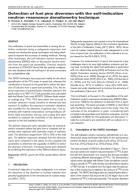Details
- Identification
- ISSN: 1977-5296, DOI: 10.3011/ESARDA.IJNSNP.2017.7
- Publication date
- 1 June 2017
- Author
- Joint Research Centre
Description
Volume: 54, June 2017, pages 54-61,
Authors: R. Rossa1, A. Borella1, P.-E. Labeau2, N. Pauly2, K. van der Meer1
1SCK•CEN, Belgian Nuclear Research Centre, 2Université libre de Bruxelles
Abstract:
The verification of spent fuel assemblies is among the activities conducted during a safeguards inspection, and several non-destructive assay techniques are being developed to improve the accuracy of existing methods. Among other techniques, the self-indication neutron resonance densitometry (SINRD) relies on the passive neutron emission from the spent fuel assemblies. Previous research conducted at SCK•CEN found that the optimal configuration was obtained with the fuel kept in air and surrounded by a polyethylene slab.
The SINRD technique was proposed mainly for the direct quantification of the 239Pu mass in spent fuel, whereas this contribution is focused on the potential to detect the diversion of fuel pins from a spent fuel assembly. First, the detector responses of several fission chambers placed in the guide tubes of a PWR 17x17 fuel assembly were calculated with the Monte Carlo code MCNPX. Different fissile material coatings (e.g. 239Pu, 238U) were taken into account to consider detectors mostly sensitive to thermal and fast neutrons. In addition, the response to ionization chambers was modelled for the detection of gamma-rays. Fuel assemblies with material compositions corresponding to different initial enrichment, burnup, and cooling time were modelled to evaluate the sensitivity of the detector responses to the fuel irradiation history.
The detector responses were calculated also for several diversion scenarios where fuel pins from a complete fuel assembly were replaced with dummies made of stainless steel. The diversions ranged from 15% to 50% of the total pins. The detector responses obtained from the diversion cases were compared to the values for the complete fuel assemblies to determine the capability of SINRD to detect the diversion of fuel pins. Promising results were obtained by combining the responses of the different detector types.
Keywords: SINRD, spent fuel, NDA, partial defect, Monte Carlo
Reference guideline:
Rossa, R., Borella, A., Labeau, P.-E., Pauly, N., & van der Meer, K. (2017). Detection of fuel pins diversion with the self-indication neutron resonance densitometry technique. ESARDA Bulletin - The International Journal of Nuclear Safeguards and Non-proliferation, 54, 54-61. https://doi.org/10.3011/ ESARDA.IJNSNP.2017.7

